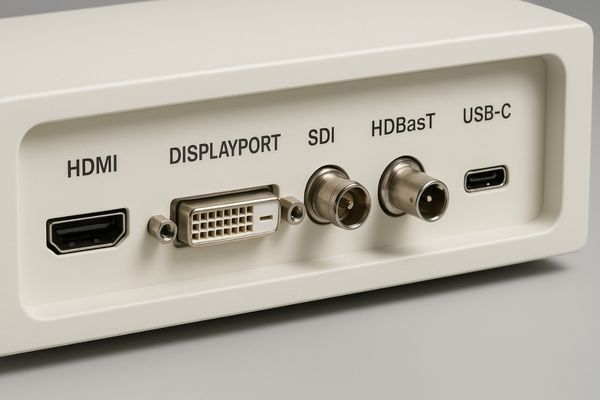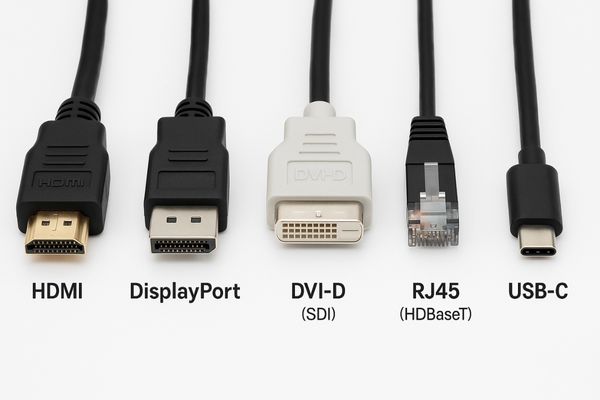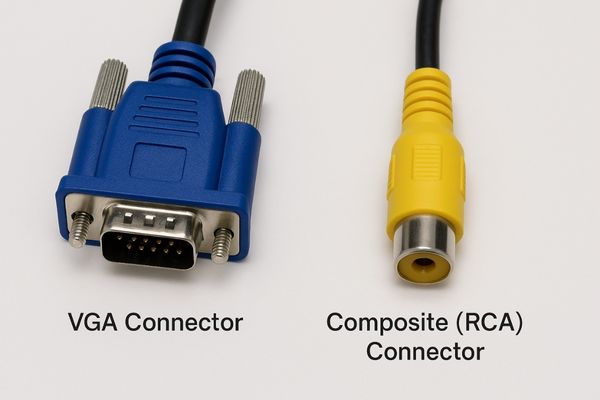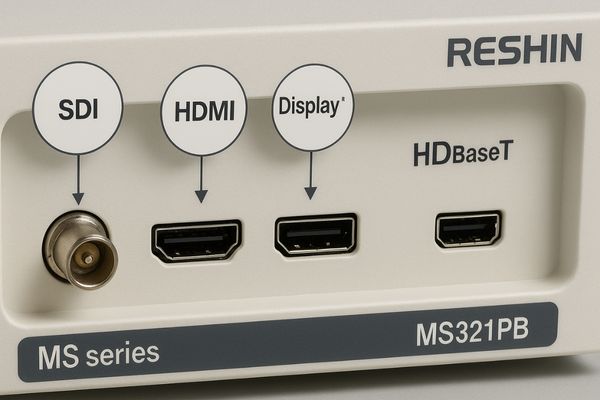Connecting various imaging devices in an operating room can be a puzzle. If monitors lack the right inputs, critical procedures can face delays. Understanding common signal interfaces is key to seamless integration.
Commonly used signal interfaces in surgical monitors include digital options like HDMI, DisplayPort, DVI-D, and critically, 3G/12G-SDI and HDBaseT for their reliability over long distances. Versatility to support multiple input types is essential.

The modern operating room is a hub of advanced technology. Various imaging systems, from endoscopes to surgical cameras, must all feed into a central display. The ability of a surgical monitor1 to connect to these diverse sources without issue is fundamental to a smooth and efficient surgical workflow. This article will explore why interface versatility2 is so important, identify the most common digital and analog inputs, discuss the role of latency and resolution, and explain how we approach connectivity in our display designs.
Why is interface versatility important in surgical displays?
Mismatched connection ports on crucial surgical devices can cause significant headaches. This incompatibility wastes valuable time and can even compromise the flow of a procedure. Having versatile interfaces ensures these systems integrate smoothly.
Interface versatility is important because operating rooms use a wide array of imaging equipment from different manufacturers. Multiple input types ensure surgical displays can seamlessly connect to these diverse systems, enhancing workflow and flexibility.

An operating room typically houses a multitude of imaging devices3, each potentially originating from a different manufacturer and employing distinct signal output technologies. We see endoscopes, laparoscopic cameras, C-arms for fluoroscopy, surgical microscopes, room cameras, and inputs from patient monitoring or navigation systems. Each of these devices might have a preferred, or sometimes proprietary, video output. For a surgical display4 to be truly effective, it must act as a universal receiver, capable of accepting signals from as many of these sources as possible. This versatility eliminates the need for a confusing array of external converters or adapters, which can be points of failure or signal degradation. It also allows surgical teams to quickly switch between different visual feeds as a procedure demands. Furthermore, as medical technology evolves, new imaging modalities and devices will emerge. A monitor with a broad range of current interfaces is also better positioned to accommodate future equipment, providing a degree of future-proofing5 and protecting the hospital’s investment. This adaptability is not just convenient; it is crucial for maintaining an efficient, uncluttered, and reliable surgical environment.
What are the most common digital input interfaces in modern surgical monitors?
Choosing the correct digital connection for precise surgical imaging can seem confusing. Making the wrong choice might lead to signal degradation, loss of detail, or transmission issues. Knowing the common digital interfaces helps ensure optimal video transmission.
The most common digital input interfaces in modern surgical monitors include HDMI, DisplayPort, DVI-D, and USB-C. For specialized surgical needs, 3G/12G-SDI and HDBaseT are favored for their robust, long-distance signal transmission capabilities.

Modern surgical monitors rely on a variety of digital interfaces to receive high-quality video signals. Here are some of the most prevalent:
Standard Digital Interfaces
- HDMI (High-Definition Multimedia Interface)6: This is a very common interface found on many devices. It supports high resolutions, including 4K, and can carry audio signals. It is suitable for shorter cable runs.
- DisplayPort (DP): Often found on computers and professional displays, DisplayPort offers high bandwidth, supporting very high resolutions and refresh rates. Some versions allow for daisy-chaining multiple monitors.
- DVI-D (Digital Visual Interface – Digital): An older digital standard, DVI-D provides a reliable, direct digital connection. It typically does not carry audio and has less bandwidth than modern HDMI or DisplayPort.
- USB-C: With DisplayPort Alternate Mode, USB-C ports can transmit video signals, data, and even power over a single cable, offering great versatility for newer devices.
Specialized Surgical Interfaces
- SDI (Serial Digital Interface)7: This is a professional broadcast-grade interface using robust BNC connectors and coaxial cables.
- 3G-SDI: Supports resolutions up to 1080p at 60Hz.
- 12G-SDI: Supports 4K UHD resolutions at 60Hz over a single cable.
SDI is highly valued in surgery for its ability to transmit uncompressed video signals reliably over long distances (often 70-100 meters or more) with very low latency.
- HDBaseT8: This technology allows for the transmission of uncompressed high-definition video, audio, Ethernet, control signals, and sometimes power over a standard Cat5e/6/7 Ethernet cable up to 100 meters. It simplifies cabling in complex OR setups.
The choice often depends on the source device, the required resolution, and the distance the signal needs to travel.
| Interface | Common Connector(s) | Max Typical Resolution/Refresh | Max Typical Distance | Key Surgical Advantage(s) |
|---|---|---|---|---|
| HDMI | HDMI Type A | 4K@60Hz (HDMI 2.0) | ~15m (passive) | Ubiquitous, audio support |
| DisplayPort | DisplayPort | 8K@60Hz (DP 1.4+) | ~3m-15m (passive) | High bandwidth, multi-stream support |
| DVI-D | DVI-D, DVI-I | 2560×1600@60Hz (Dual Link) | ~5m-15m | Secure connection, common legacy digital |
| 3G-SDI | BNC | 1080p@60Hz | ~100m+ | Long distance, robust, low latency |
| 12G-SDI | BNC | 4K@60Hz | ~70m-100m | 4K over single cable, robust, low latency |
| HDBaseT | RJ45 (Cat5e/6/7) | 4K@30Hz (uncompressed) | ~100m | Single cable for video/audio/control |
| USB-C (DP Alt Mode) | USB Type-C | Matches DP Alt Mode (e.g. 4K@60Hz) | Variable | Versatile, potential power delivery |
How do legacy analog interfaces remain relevant in surgical settings?
Older surgical imaging equipment often relies on outdated analog connection types. This can create immediate compatibility challenges when integrating with newer, digital-focused displays. However, continued support for these interfaces offers valuable flexibility.
Legacy analog interfaces like VGA or Composite remain relevant by providing compatibility with older, still-functional surgical equipment or serving as backup inputs. This support helps healthcare facilities manage transitions and costs during equipment upgrades.

While the medical field is rapidly moving towards fully digital imaging pathways, analog interfaces have not entirely disappeared from surgical environments. There are practical reasons for their continued, albeit diminishing, relevance.
Common Legacy Interfaces
- VGA (Video Graphics Array)9: This was once the standard analog connector for computers and many medical devices. It can support reasonable resolutions but is susceptible to signal degradation over longer distances and interference.
- Composite Video10: Typically using a single yellow RCA connector, this interface carries a low-resolution analog video signal. It is found on very old equipment.
Reasons for Continued Support
Many hospitals operate under tight budgetary constraints. They may have older imaging equipment, such as an auxiliary camera or a specific diagnostic tool, that is still perfectly functional but only offers analog outputs11. Replacing such equipment solely due to its interface can be cost-prohibitive. Surgical displays that include legacy analog inputs allow these institutions to continue using their existing assets, facilitating a more gradual and financially manageable transition to newer technologies. Additionally, in some rare cases, an analog input might serve as a rudimentary backup if a primary digital connection fails, providing at least some visual information. While the image quality from analog sources is inherently inferior to digital, their presence on a monitor can be a pragmatic solution during these transitional phases in healthcare technology.
What role does latency and resolution support play in interface selection?
Laggy video feeds or blurry, indistinct images during a surgical procedure are unacceptable and potentially dangerous. Such issues can directly lead to errors and negatively affect patient outcomes. Therefore, selecting interfaces that deliver high resolution with minimal delay is absolutely essential.
Latency and resolution support are critical: interfaces must deliver high-resolution (e.g., 4K) images with minimal delay (low latency) to ensure surgeons see clear, real-time visuals. This is vital for precise movements and hand-eye coordination.

The choice of signal interface directly impacts two critical aspects of surgical imaging: the clarity of the image (resolution) and the immediacy of the visual feedback (latency).
Resolution Requirements
Modern surgical procedures, especially minimally invasive techniques, rely on highly detailed visualization of anatomical structures. Interfaces must support the native resolution of the imaging source, whether it is Full HD (1920×1080), 4K UHD12 (3840×2160), or even higher. Insufficient bandwidth in an interface can lead to compromised image quality13, forcing the signal to be downscaled or compressed, thereby losing crucial detail. Digital interfaces like HDMI 2.0+, DisplayPort 1.4+, and 12G-SDI are designed to handle the large data streams required for 4K and higher resolutions at fluid refresh rates (e.g., 60Hz).
Importance of Low Latency
Latency refers to the delay between an action occurring in the surgical field and it being displayed on the monitor. In surgery, particularly for procedures requiring precise hand-eye coordination like endoscopy or robotic surgery, high latency can be disorienting and dangerous. Surgeons need to see their instrument movements in real-time. Interfaces like SDI are known for their inherently low latency14. While all digital processing introduces some delay, the goal is to minimize this "glass-to-glass" latency. The interface itself, along with the display’s internal processing, contributes to the total latency. Selecting an interface that transmits the signal efficiently and choosing a monitor with fast internal processing are key to achieving the near-instantaneous visual feedback necessary for surgical accuracy and patient safety.
How does Reshin ensure broad compatibility with surgical imaging systems?
Connecting a variety of specialized imaging systems to our monitors might still seem like a complex task. A fear of incompatibility or difficult setup could understandably deter potential users. For this reason, we design our displays with maximum connectivity and ease of use in mind.
We ensure broad compatibility by equipping our surgical monitors, such as the MS series, with a comprehensive range of modern digital inputs including HDMI, DisplayPort, SDI, HDBaseT, and USB-C, often featuring automatic signal detection for ease of use.

We understand that the modern operating room is a dynamic environment with a diverse ecosystem of imaging equipment. To address this, our surgical monitors15, particularly within the MS series (such as the MS321PB), are engineered with a focus on versatile connectivity. This means incorporating a wide selection of input interfaces to accommodate most, if not all, common surgical imaging sources. Typically, our monitors will feature multiple HDMI and DisplayPort inputs for general-purpose high-definition sources like computers or mobile C-arms. Crucially, for the demanding needs of surgical video, we include professional-grade interfaces like 3G-SDI and 12G-SDI16, which are ideal for long-distance, low-latency connections from endoscope cameras and other OR-specific systems. Some models also offer HDBaseT for simplified single-cable installations or USB-C for newer portable devices.
Beyond just providing the physical ports, we often implement features like automatic signal detection17. This intelligence allows the monitor to automatically identify and switch to an active input source when a device is connected, minimizing the need for manual configuration by the surgical team. This "plug-and-play" approach saves valuable time during OR setup. Our commitment involves rigorous testing with a wide array of imaging systems to ensure reliable performance and seamless integration, helping our customers achieve efficient and effective visualization in their surgical workflows.
Conclusion
Versatile, high-performance signal interfaces are fundamental to modern surgical monitors. They ensure compatibility, deliver critical image data accurately, and support efficient operating room workflows for optimal patient care. To explore surgical displays with advanced connectivity solutions, contact Reshin at martin@reshinmonitors.com.
-
Understanding the features of surgical monitors can enhance your knowledge of their importance in modern operating rooms. ↩
-
Exploring the significance of interface versatility can provide insights into improving surgical workflows and technology integration. ↩
-
Learn about the various imaging devices used in operating rooms and their importance in surgical procedures. ↩
-
Explore this link to understand the essential features that make a surgical display effective in a modern operating room. ↩
-
Discover strategies for future-proofing medical equipment to protect hospital investments and adapt to technological advancements. ↩
-
Explore the benefits of HDMI in surgical settings, including its high resolution and audio capabilities, essential for modern medical procedures. ↩
-
Learn how SDI enhances video quality and reliability in surgeries, making it a preferred choice for medical professionals. ↩
-
Discover how HDBaseT technology streamlines video and data transmission in operating rooms, improving efficiency and setup. ↩
-
Explore the significance of VGA in medical imaging and its impact on transitioning to digital technologies. ↩
-
Learn about Composite Video’s role in older medical equipment and its implications for healthcare technology. ↩
-
Discover the reasons behind the continued use of analog outputs in medical devices and their practical benefits. ↩
-
Discovering the advantages of 4K UHD can lead to better visualization and improved surgical techniques. ↩
-
Understanding image quality factors is crucial for improving surgical outcomes and ensuring patient safety. ↩
-
Exploring the significance of low latency can enhance surgical precision and reduce risks during operations. ↩
-
Explore this link to discover top-rated surgical monitors that enhance efficiency and visualization in the operating room. ↩
-
Understanding the differences can help you choose the right interface for your surgical video needs, ensuring optimal performance. ↩
-
Learn about this feature to see how it can streamline your surgical workflow and improve efficiency during procedures. ↩

